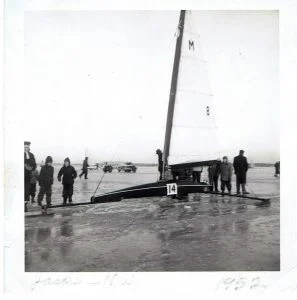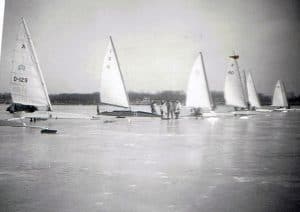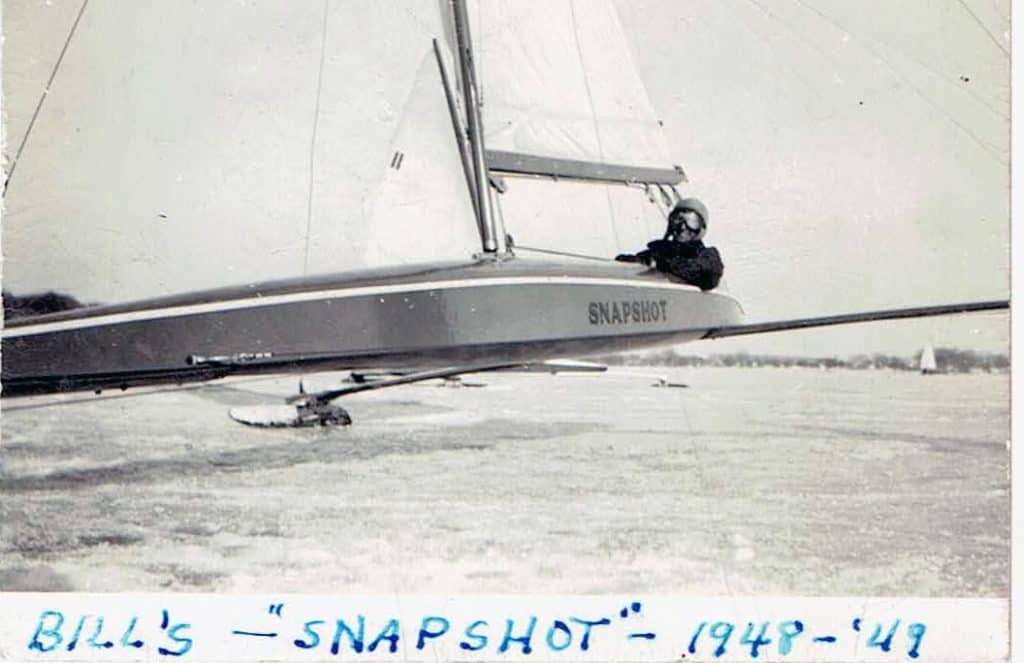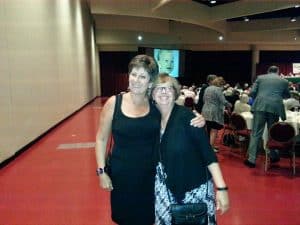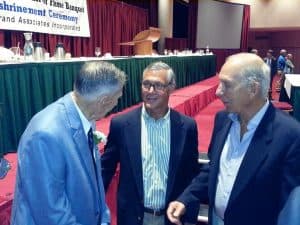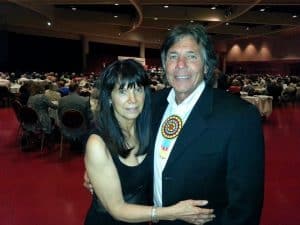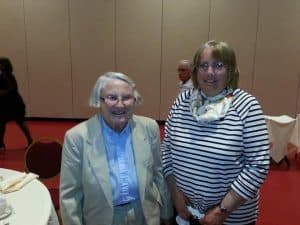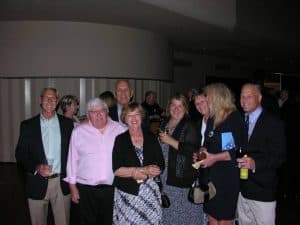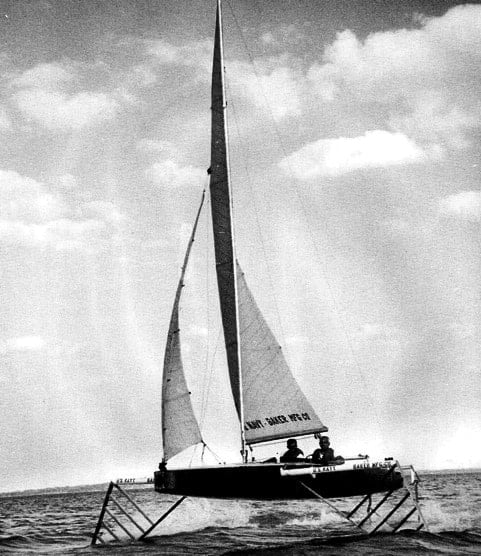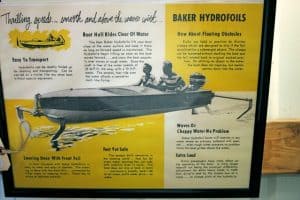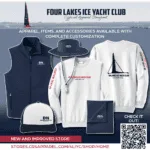2017-2018 Season Archives
2017-2018 Archives
2017-2018 Season:
- DN Regattas
- Northwest Regatta CANCELLED FOR THE SEASON
- International Skeeter Association and Renegade Championship POSTPONED UNTIL DECEMBER 2018
More 1952 Northwest Regatta Photos
A Surprise in the Mail: Part 3
Renegader Jerry Simon had a look through the scrapbook that I recently received and spent a few enjoyable hours identifying boats and putting the photos in context. We’ve concluded that the scrapbook did indeed belong to Herb Krogman who sailed Renegades and Skeeters with the Four Lakes Ice Yacht Club in the 1950s. There are quite a few pictures from the 1952 Northwest which was sailed on Lake Monona. History records that Bill “Curley” Perrigo won the Skeeter title that year in THUNDERJET. The 1950s were a time of rapid technological development in the Skeeter class and a transition from Skeeter to what would become the Renegade class.
1952 Northwest: O ME – O MY

O’ME – O’MY Skeeter Ice Boat Club sailor Chuck Edwards at the 1952 Northwest on Lake Monona, Madison, WI
A Surprise in the Mail: Part 2
I’ve been going through the scrapbook that recently arrived in the mail and finding photos that are in need of stories to go with them. We are lucky to have iceboaters who are willing to take time to share what they remember. Jane Pegel is one of them. I sent her this photo and she wrote back with the following information:
O’ME O’MY was Chuck Edwards. An absolutely outstanding sailor and a very nice guy. Chuck’s family had a home on the north shore of Geneva Lake and Chuck successfully raced C scows beginning in the 1930’s.
Buddy [Melges] told me last winter that Chuck Edwards was the first person to realize that weight of the C scow was important.
In Skeeter Ice Boat Club records, I found Chuck —
1939, Season standings 5th
1940, winner of the Nye Trophy
1950, Season standings, 2nd.Chuck and his wife lived in a gorgeous house on Lac LaBelle in Oconomowoc, close to the dam. When I was sailing in regattas at LaBelle I would stop in to chat with Chuck. Chuck’s son, George, had a rumble seat C Skeeter with a Nite mast and sail. The last time I saw Chuck and his wife was at Cuppy Goes’ funeral. Cuppy also was a C scow champion, actually had a fast sail that had originally been Chuck Edwards’ sail. Cuppy was born in December, 1917. I imagine Chuck Edwards was close in age to Cuppy.
A Surprise in the Mail
A package recently arrived here at iceboat.org containing an old scrapbook filled with newspaper clippings and black and white photos of the Madison iceboating scene from the late 1940s through 1950s. Herb Krogman may have assembled this historic scrapbook and Renegader Jerry Simon has volunteered to look through it to help confirm my suspicions.(By the way, if you sent this to me, please send send me an email so that I can thank you!)
In the meantime, here are a few photos for now. I’ll continue to scan and post more in the coming weeks.
A Note from the Mattisons
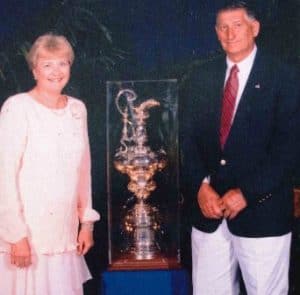 A message from Bill and Mauretta Mattison:
A message from Bill and Mauretta Mattison:
Thanks to the iceboat and sailboat groups for their support of Bill in conjunction with his induction in the Madison Sports Hall of Fame.
Bill really appreciated the support, from e-mails, phone calls and personal contact. He really hopes this broke “the ice” for his beloved sport(s).
2 Minute Mast
Fascinating time lapse video of Hungarian DNer Peter Hamrak conjuring up a DN mast.
Mattison’s Madison
The area sailing community turned out in force for Bill Mattison’s induction into the Madison Sports Hall of Fame on June 7, 2017 at the Monona Terrace Convention Center. Jane and Susie Pegel represented Geneva Lake’s Skeeter Iceboat Club, the Harkens, Perrigos, and Carole Miller were there from Pewaukee, and a big contingent from the Green Lake Ice Yacht Club added to the fun of the evening. The above video was produced by the Madison Sports Hall of Fame and was shown as part of Bill’s induction. Don Sanford and Steve Holtzman deserve a lot of credit for their efforts that resulted in this wonderful evening. Thanks to John Hayashi for taking the social photos.
Frank Lloyd Wright & Iceboating
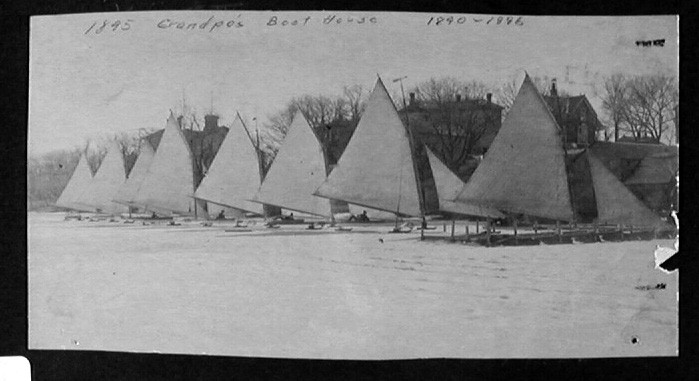
The Charles Bernard Boathouse Stern Steerer iceboat fleet on Lake Mendota. Frank Lloyd Wright’s elementary school is in the background. Though the photo dates from 1895, Wright would have seen the same boats on Lake Mendota back in the 1880s. Photo from the Bernard scrapbook collection.Notation by Carl Bernard.
On the anniversary of the great architect, Frank Lloyd Wright’s 150th birthday, the Madison Children’s Museum is hosting a 3 day event that will include an exhibit dedicated to the iceboat models he made as a boy. The exhibit dates are June 7 – 10. Learn more about it at their website.
Wright moved to Madison when he was 12 years old in 1879 and lived near the Bernard Boathouse, the center of ice sailing on Lake Mendota. He attended Lincoln School which was also on Lake Mendota, a few doors east of the Boathouse, where stern steerers gliding across the lake would have been a common sight. What a distraction and inspiration that must have been for the students!
One of Wright’s biographies mentions that he made model iceboats as a boy. Though none of Wright’s boyhood iceboat models exist, a sophisticated model made by William Bernard (and restored by Bill Mattison) is in the collection of the Wisconsin State Historical Society. Read about that on the WSH website.
I suspect that Wright, along with many boys in the neighborhood, would have spent time at the Bernard Boathouse watching Charles and William build boats. It would have been an exciting place for a boy with an inclination to become an architect.
We know from a recording of Carl Bernard in the Wisconsin State Historical Society archives that when he was in Madison, Wright continued to drop in on the “boys at the Boathouse”. It could have been at the Boathouse where learned of master carpenter and iceboat builder, Frank Tetzlaff, famous for his part in building the MARY B stern steerer. In the early 1950s, Wright’s complicated roof design for Madison’s Unitarian Meeting House was proving difficult to build. It was Frank Tetzlaff who “helped translate” Wright’s plans.
Frank Lloyd Wright, much like the aviator Charles Lindbergh during his brief stay here, was drawn to the sport of iceboating and the people in Madison who were obsessed with building and sailing them.
Foiled Again
Because we are on the eve of another America’s Cup yachting competition, it is time to look back to 2013 and review two posts about foils, one of the big reasons that AC boats have such tremendous speed.
Odd but true, f oiling boats were tested on our own Lake Mendota in Madison, Wisconsin. Three of our club members, Skeeter skipper Bill Mattison, Renegader Jack Ripp, and Renegader Paul MacMillan remember seeing an experimental boat with foils on Lake Mendota in the 1950s. I was able to track down an article about it. In 1947, the firm engineering staff of the Baker Company in Evansville, WI had done some research on hydrofoils and tested the boat out on Lake Mendota. Read the article from Madison’s Capital Times dated November 26, 1959.
oiling boats were tested on our own Lake Mendota in Madison, Wisconsin. Three of our club members, Skeeter skipper Bill Mattison, Renegader Jack Ripp, and Renegader Paul MacMillan remember seeing an experimental boat with foils on Lake Mendota in the 1950s. I was able to track down an article about it. In 1947, the firm engineering staff of the Baker Company in Evansville, WI had done some research on hydrofoils and tested the boat out on Lake Mendota. Read the article from Madison’s Capital Times dated November 26, 1959.
Now, for the rest of the story.
Nite skipper Don Sanford was kind enough to share with us an excerpt from his now published book, On Fourth Lake, the Social History of Lake Mendota.
Flying Boats?
PDF version
c. 2013 Donald P. Sanford
” This year’s America’s Cup was the first time most armchair sailors had seen a sailboat go faster than the wind. But for a handful Madison iceboaters including Bill Mattison and Jack Ripp it was deja-vu. They’d seen it all before–one day in August, 1955 when the Monitor flew across Lake Mendota.
In the mid-1930s, Gordon Baker raced E Scows with the Mendota Yacht Club in Madison. Gordon was a great sailor because he really knew something about wind power. That’s because the family business, Baker Manufacturing in Evansville, WI, was one of the country’s foremost manufacturers of windmills. Gordon began experimenting with hydrofoils in the 1940s and launched his first prototype hydrofoil, a sailboat, in 1950 at the University Boathouse on Lake Mendota. Based on its success, Baker Manufacturing soon introduced a hydrofoil kit for powerboats in 1953. Once installed, a 14-foot boat with a 10-horsepower motor could reach speeds of 35 miles per hour.
With some funding from the U.S. Navy’s Office of Naval Research, Baker continued to perfect the designs on his hydrofoil next sailboat, the Monitor. On August 25, 1955, Baker and his colleague Robert Johnston climbed aboard Monitor and headed for the open water of Lake Mendota off Picnic Point. As the boat’s speed increased, Monitor’s hull lifted onto a set of three ladder-shaped hydrofoils. With her high-aspect sails, Monitor literally flew across Lake Mendota at 25 knots (28.7 mph), setting a new speed record for a sailboat of any kind. Footage of the event was shown on ABC-TV’s John Daly and the News and photos of the boat were featured in Sports Illustrated and Life magazines later that year. A year later, Monitor set another record on Mendota, reaching 30.4 knots (35 mph), or twice the speed of the wind.
iceboat.org Graduates to WordPress
If iceboat.org was a kid, it would be graduating from high school this spring and heading off to college in the fall (on a sailing scholarship,of course). This website went online 18 years ago in November 1999 and has had over 2 million page views. Thank you for all those looks!
Much like the technology of our sport, I try to keep this website moving forward and the “runners sharpened”. During the past few weeks, I’ve made some long overdue major changes to the website by switching it over to a WordPress platform. The basic design is still the same but here’s how it may affect your browsing experience:
- Subscribe: Never miss a post! Sign up to receive an email every time I post something. If you are on a laptop, you will find the form on the right side bar. Tablet and mobile users will have to scroll down towards the bottom to see the form.
- Share: Facebook users can now share a post or a page on their Facebook page. There’s a share button at the bottom of each post and page.
- “Classic” iceboat.org: Don’t worry, it’s still online. The old website can be accessed and there’s a red button on top the right sidebar that links to it.
- Bookmarks: You may have to update your browser’s bookmarks if you have any pages here saved as favorites.
- Broken Links?: Please let me know if you run across any problems so that I can fix them.
- Missing Your Favorite Page?: Again, please let me know so I can find it and fix it.
Another advantage of the WordPress platform is that I now have the ability to post to this website from my phone. Thanks again to members of the greatest iceboat club in the universe, the Four Lakes Ice Yacht Club, for letting me have so much fun with this website.
Deb
Ghost on the Horizon
 The GoPro camera era has been a boon to ice sailing and has exposed it to a wider audience because the sport expresses well visually. Now here’s something new brought to you by Canada’s SESQUI programming, a GoPro on a radio controlled 4 wheeled vehicle traveling side by side with iceboats. This is part of s …”cinematic journey across Canada… Created and captured with advanced 360° technology and presented in full dome and virtual reality platforms…” The ice sailing part was filmed on Ghost Lake in Alberta Canada. See the trailer for the video here. The iceboat bit starts at 1:08.
The GoPro camera era has been a boon to ice sailing and has exposed it to a wider audience because the sport expresses well visually. Now here’s something new brought to you by Canada’s SESQUI programming, a GoPro on a radio controlled 4 wheeled vehicle traveling side by side with iceboats. This is part of s …”cinematic journey across Canada… Created and captured with advanced 360° technology and presented in full dome and virtual reality platforms…” The ice sailing part was filmed on Ghost Lake in Alberta Canada. See the trailer for the video here. The iceboat bit starts at 1:08.


